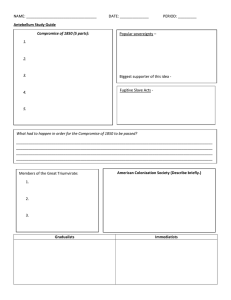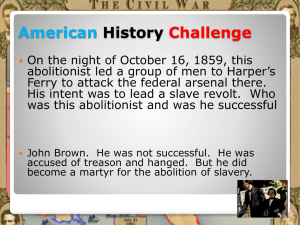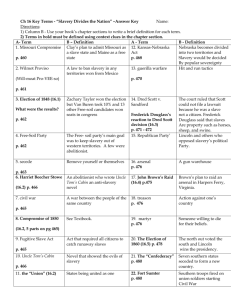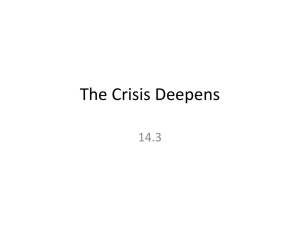History Alive Name: ______________________________ Grade 7
advertisement
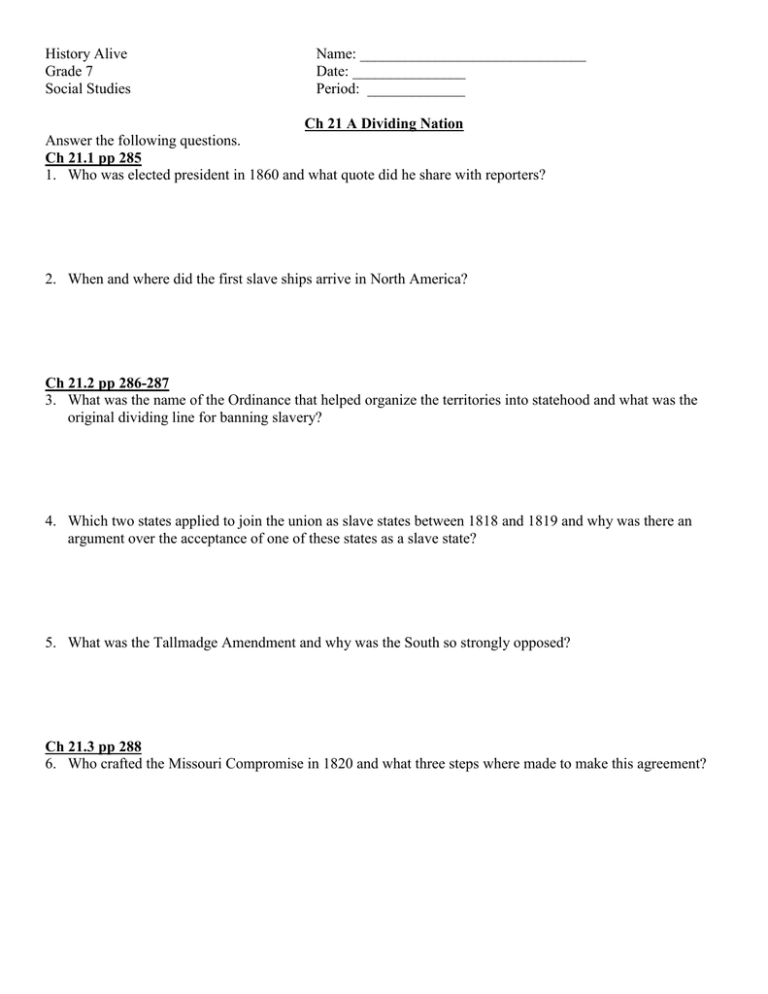
History Alive Grade 7 Social Studies Name: ______________________________ Date: _______________ Period: _____________ Ch 21 A Dividing Nation Answer the following questions. Ch 21.1 pp 285 1. Who was elected president in 1860 and what quote did he share with reporters? 2. When and where did the first slave ships arrive in North America? Ch 21.2 pp 286-287 3. What was the name of the Ordinance that helped organize the territories into statehood and what was the original dividing line for banning slavery? 4. Which two states applied to join the union as slave states between 1818 and 1819 and why was there an argument over the acceptance of one of these states as a slave state? 5. What was the Tallmadge Amendment and why was the South so strongly opposed? Ch 21.3 pp 288 6. Who crafted the Missouri Compromise in 1820 and what three steps where made to make this agreement? Ch 21.4 pp 289-290 7. During the 1830’s Abolitionists flooded Congress with anti slavery petitions. Congress reacted with the “Gag Rule”. What was the Gag Rule and what did John Quincy Adams attempt to propose in 1839? 8. Who was Nat Turner and how did some southern states react to this opposition? 9. Why did Southern slaveholders demand a law for runaway slaves? 10. California applied for Statehood as a free state. Why was this so greatly resisted by Southerners? Ch 21.5 pp 291 11. In January of 1850 Henry Clay and Daniel Webster formulated the Compromise of 1850. List the four changes in the Compromise and assess who may have benefited from each change. Ch 21.6 pp 292-296 12. What was the Fugitive Slave law? Why was the North opposed and what were consequences for not following this law? 13. Harriet Beecher Stowe wrote Uncle Tom’s Cabin in 1852. Who were three characters in the novel, what happened to them, and why did Abraham Lincoln say this was “the book that made this great war?” 14. Stephen Douglas introduced the Kansas Nebraska Act. It promoted popular sovereignty to determine the slave issue in these territories. What does popular sovereignty means and why was the North so upset by this new Act? 15. In 1857 Chief Justice Roger Taney ruled in the Dred Scott case. What was the issue in this case and how did the Justice try to address the global issue of slavery using this case? Ch 21.7 pp 297 16. Who was the Chief Justice for the Dred Scott opinion and what did he declare as a young Maryland Lawyer? 17. Why was Dred Scott denied his ability to sue for freedom and what did the court decide about the Missouri Compromise? 18. Northerners were stunned and outraged by the Dred Scott decision. What did two New York newspapers call the decision? Ch 21.8 pp 298-299 19. During the Kansas Nebraska Act a new anti slavery party was formed. What was the name of the party and the four central beliefs that they held? 20. In 1858 Abraham Lincoln was nominated to run for Senate. What quote did he share from the bible and what was he his beliefs about a divided nation? 21. When Lincoln debate Douglas about slavery what were the views of each and who won the election for Senator? 22. Who was John Brown? What was his plan of action and what quote did he leave behind? 23. In the presidential election of 1860 the country was divided behind 4 candidates. Who were they and what political parties did they come from and how did this aid Lincoln in his run for president? Ch 21.9 pp 300 24. In 1860 President Lincoln was asked about supporting a compromise on slavery. What were his comments on slavery in the south, the fugitive slave law and slavery in the territories? 25. On this same day an announcement was made in Charleston South Carolina. What was this announcement and how did the town respond? 26. What was President Lincoln’s opinion about secession from the union and how did the south respond on April 12, 1861? 27. What was the North’s response to the loss of Fort Sumter?

